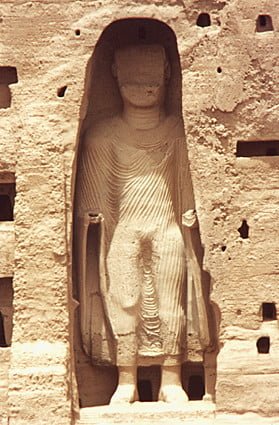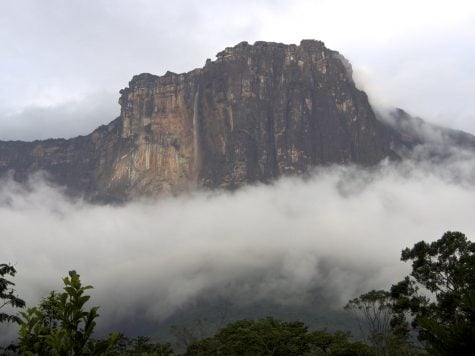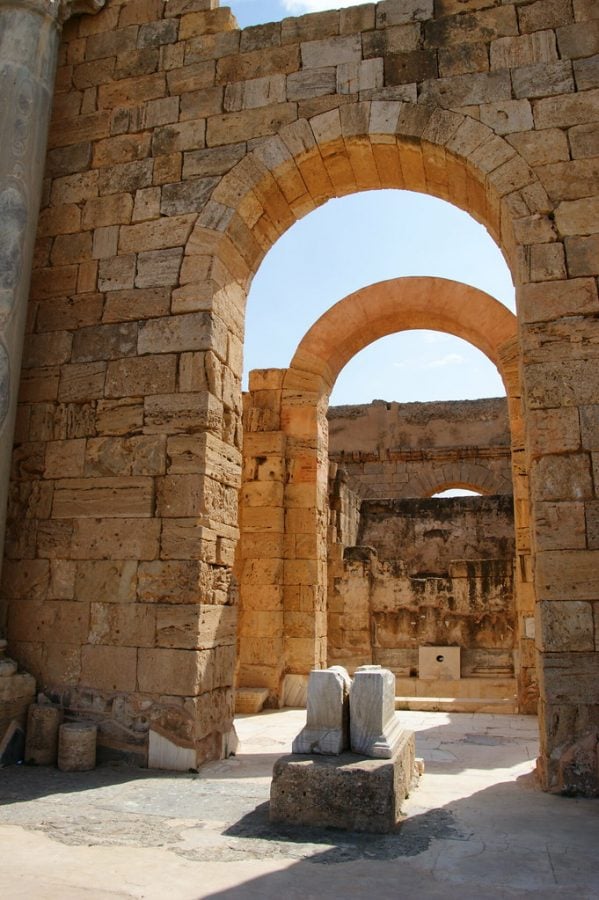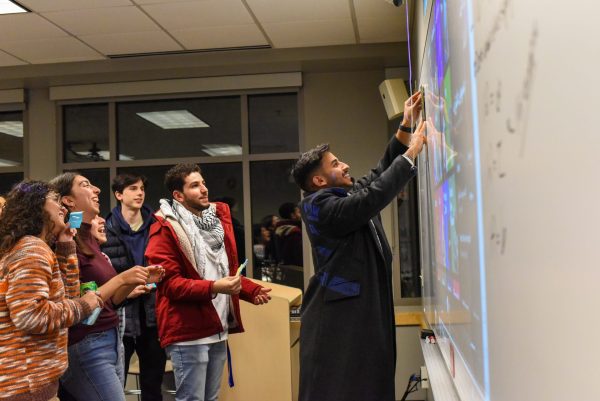Unofficial wonders of the world may be lost in countries plagued by civil unrest
PHOTO COURTESY OF ROB STOELTJE VIA FLICKR
Leptis Magna offers connections to Libya’s ancient times.
Mark DeLancey, associate professor and chair of history and architecture at DePaul University, sits across the table in his fourth-floor office. Windows give way to an almost distracting view of the Chicago skyline, and illuminate a bookshelf filled with a vast array of work on the Islamic world. He has studied Islamic art and architecture for nearly three decades.
He tells of extravagant art and grand forms of architecture throughout the Middle East and parts of northern Africa, highlighting the differences amongst them, but also noting similarities. From the questioner’s point of view, however, the most relevant similarity is their existence in countries on the Department of State’s Do Not Travel list.

Buddhas of Bamiyan replaced by holographic imagery following destruction by the Taliban in 2001.
“Keep in mind that many of these countries you can visit, just not on an American airline, so you’ve got to get off in Europe and jump through some hoops,” DeLancey said. “But it makes it a little more difficult. But what do you miss? You miss a sense of our common humanity with these places.”
The U.S. Department of State has issued 13 countries with a Level Four “Do Not Travel” advisory, the highest such ranking there is. Countries with a Level Four advisory are characterized by civil unrest, terrorism, armed conflict and other forms of instability. Until such issues are resolved, they are not likely to be visited. The concerns of visiting such countries, while valid, prevent people from seeing art, architecture and natural beacons of beauty.
Stephanie Howell, a communications professor specializing in intercultural communications, said art holds invaluable insight into culture.
“Art can give insight into cultural values,” Howell said. “Art can give insight to rituals. Art can give insight into traditions, holidays and performative practices. Art can give insight into that culture’s history.”

The Great Mosque of Damascus holds hundeds of thousands of years of history within its walls.
Art and architecture are key pieces of the human experience that we often miss out on. The instability that put such countries on the Do Not Travel List deprives people not only of experiencing what is often a touchstone of another culture, but prevents any firsthand appreciation of what a culture has to offer. Windows into the past, embodied representations of culture or simply the grandeur of a natural structure are all things we are deprived of.
“If we are considering architecture as an art, and the question is, ‘How does art serve as a window into the past help us better understand culture(s)?’ then we have established that art and architecture is a window to that culture’s history in the framing,” Howell said. “The art gives us context. Again, the art can give us insight into cultural values and understandings.”
DeLancey points to Leptis Magna, located in Libya, as an example of a landmark that brings perspective to the times of ancient Libya.
“It was a major city in North Africa,” he said. “They engaged in Mediterranean trade, particularly because the Severan Dynasty originated there.”
The history of Leptis Magna also reveals the importance of North Africa to the Roman Empire, something often overlooked in evaluating its global reign.
“I like to also point out that Rome is African too,” DeLancey said. “North Africa was the breadbasket of the Roman Empire. And a whole imperial family originated in Leptis Magna.”
Leptis Magna is one of many connections to the past and archaeological sites that most people are likely never to see. Iraq’s ruins of Samarra stand tall today, despite their construction in the eighth century. The Fakhr ad-Din Mosque in Somalia, the Maidan i-Shah in Iran and the Great Mosque of Damascus in Syria are all remnants of history spanning hundreds to thousands of years. Empires have risen and fallen since their creation. The site of the Great Mosque of Damascus has been repurposed for multiple religions and has withstood the instability in Syria. DeLancey said the ancient remains of Samarra played a role in the Iraq War.
“At one point in time, Samarra was in the news all the time as a site of resistance in the Iraqi War,” he said. “And one of these minarets, in fact, was used as a sniper nest. And it was in the news for a period of time.”
On the other side of the globe, in Venezuela, exists the largest waterfall in the world: Angel Falls. Those familiar with the movie “Up” may recognize it, as it was the site on which Carl landed his floating house. They called it Paradise Falls in the movie, but at one point in time, it was possible to experience part of a Pixar film in real life.

Angel Falls served as the inspiration for “Paradise Falls” in Disney’s “Up.”
Now, Angel Falls is largely inaccessible. Venezuela, under authoritarian rule by Nicolás Maduro, has been shaken by food shortages, corruption and violence. Travel there has become nearly impossible. Josely Hernandez, a 21-year-old student at Waubonsee Community College, born in Maracaibo, Venezuela, said there have been many changes since she moved to the U.S. at 3 years old.
“We went back a lot to visit, but as things got worse, it got more expensive to go visit and a lot more difficult, so we didn’t really get the opportunity to go back,” Hernandez said. “And at the moment it’s kind of discouraged, so we don’t really get the opportunity to go back anymore.”
Hernandez said Angel Falls is a place that sticks out in her mind when she thinks about Venezuela because her brother is a pilot who has toured the location.
“It’s always beautiful and it’s always providing life to everything around it,” she said. “And I feel like, if at some point in time, the government got shut down or kicked out or whatever, I feel like Venezuela could have the opportunity to rebuild itself and make it how it used to be when my parents were younger.”
The world is home to great depths of architectural marvels and places of beauty. Unfortunately, as has been the case throughout global history, that beauty can become a target. The Buddhas of Bamiyan in Afghanistan, formerly the largest Buddha statues in the world, are an example of this, as they were destroyed by the Taliban in 2001.
In a sense, the Buddhas were resurrected in 2015. Through holographic imagery in the vacant space they once occupied, they attracted visitors and were met with general approval. Though on the surface it seemed to be a purely positive act, there is cause to be wary of the statues’ rebirth, according to Robert Linrothe, associate professor and chair of the department of art history at Northwestern University.
Linrothe, who earned his art doctorate from the University of Chicago in 2016, said the problems posed by “resurrecting” art include the privilege it gives to our understanding of art compared to its original creators. He said part of the reason for the Buddhas’ prominence was that it served as a beacon for travelers along the Silk Road. Replacing them with a hologram changes the meaning of their placement.
Linrothe also noted the importance of art in residing in its original location. Stripping paintings or statues from their original place in the world, and therefore their place in history, removes them from the context their creator intended. The world’s finest places of beauty are meant to be respected, and as awe-inspiring as they can be, the temptation to recreate them can be problematic. 
The best way to view them is in their original state, which means many of these places won’t be available for some time.
Unfortunately, this is a reality of landmarks that exist in places of armed conflict. Destroyed remnants of the past can’t be rebuilt and viewed later while keeping the artist’s original intent. And along with the Buddhas of Bamiyan, some of these connections to the past are disappearing.
“There are so many creative and inspirational pieces that I won’t be able to see and admire. It makes me wonder what I’m missing out on,” said Michael Harris, a senior at DePaul.
What still remains, DeLancey said, serves a role in the human experience
“I think it changes your perspective on how people in those parts of the world relate to us in the wider world,” he said. “It gives you a sense that there is something of value there as well. These aren’t just empty places, these are places where there are extraordinary monuments to human civilization and what people are capable of. I think those are important things that we miss out on.”







